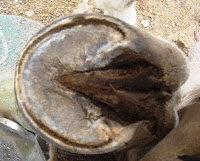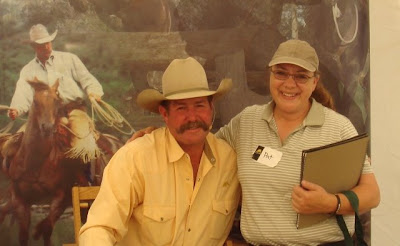Larry, his owner, told me Parelli’s name had been changed to Amado when they got him, which is Spanish for beloved. In his case, this name truly fits this horse.We don't have a complete history on Amado’s, but as best as we know, he’d been with several owners. All, I’m told, cared about him very much. He’s had many hours of training, but when he was 5 years old, he developed lameness and was eventually labeled navicular.As with most young horses going into work, shoes are applied, however, in Amado's case, it's unknown whether a competent or incompetent shoeing job was done. In my opinion, his shoes and the application of them are what started Amado down this path and eventually sent him, (and many other horses in his similar situation) to death's door.After years of trying to restore sound hooves in him with corrective shoeing, he could not walk and was sent to the feedlot for slaughter. That, sadly, is a very common scenario for many horses. Almost as many horses are put down due to hoof issues as all other causes of equine death combined.

(Amado before deshoing)
Amado was rescued from the feed lot by an organization called SAFE. “Save a Forgotten Equine.” He lived in foster care and was put into a natural balanced type of shoeing system that helped him move around again. Although, a corrective boot, such as the Soft-ride Comfort Boots, likely would have accomplished the same goal. Every shoeing cost about the same as one pair of those boots.
Amado shoes were very expensive and he became so difficult for his farrier’s that the last two refused to return and not many farriers are familiar with applying this type of shoe.
Larry’s options for his horse were becoming limited. That when he contacted me.The shoes, which saved his life, also came with a price. His frogs were so over-protected they had simply been rotting away. The entire hoof was taken out of function, other than weight-bearing.
Larry, advised me that Amado didn’t move around much. He spent most of his time standing.That was apparent in his body condition. He seemed to hold himself together with strained muscles.

While I’ve known him, Amado has been very sweet and cooperative. Definitely not dangerous, but then I’m not nailing unorthodox shoes onto his sensitive hooves either.
THE SHOES
 Amados rehab shoes. These shoes are what actually helped Amado begin to move comfortably. There was quite a smell of rotting tissue upon removing them.
Amados rehab shoes. These shoes are what actually helped Amado begin to move comfortably. There was quite a smell of rotting tissue upon removing them.


 Before and After First Trim
Before and After First Trim As you can see from the photos above, Amado’s soles had generated a massive amount of dense tissue. The walls were long, so the sole found a way to keep up with the wall growth. His heels were extremely tender and his frogs were almost non-existent.
After deshoing, as with any navicular horse, he was definitely stabbing his toe with each step. His heels couldn’t take the pressure of a proper heel first landing. He didn’t seem to be in pain as much as just feeling discomfort and protective of his heels.
After a few trims, the reports on Amado were that he was running and bucking and even jumping small obstacles.
FIFTH TRIM
 By his 5th trim appointment, his hooves were landing flat as opposed to toe-first, and that dense packed-in sole material had finally let go and sloughed. He was moving so much better and his body didn’t exhibit the tense muscling that I saw originally.
By his 5th trim appointment, his hooves were landing flat as opposed to toe-first, and that dense packed-in sole material had finally let go and sloughed. He was moving so much better and his body didn’t exhibit the tense muscling that I saw originally.
After deshoing, as with any navicular horse, he was definitely stabbing his toe with each step. His heels couldn’t take the pressure of a proper heel first landing. He didn’t seem to be in pain as much as just feeling discomfort and protective of his heels.
After a few trims, the reports on Amado were that he was running and bucking and even jumping small obstacles.
FIFTH TRIM
 By his 5th trim appointment, his hooves were landing flat as opposed to toe-first, and that dense packed-in sole material had finally let go and sloughed. He was moving so much better and his body didn’t exhibit the tense muscling that I saw originally.
By his 5th trim appointment, his hooves were landing flat as opposed to toe-first, and that dense packed-in sole material had finally let go and sloughed. He was moving so much better and his body didn’t exhibit the tense muscling that I saw originally.
 SIXTH TRIM
SIXTH TRIMBy the 6th trim, which I term the “magic trim” trim, I could see a dramatic improvement of his frog development and sole concavity. We still have to continue shortening the toes and there is still some white line separation, but that will self correct as he becomes sound again and is landing heel first.

So, here is a lovely gelding who was destined for dog food because of his hooves. That is just about as wrong as it can get for a horse. I’m sure if his owner who lost hope and sent him to be slaughtered could see him now, he wouldn’t believe he is the same horse.
These horses desperately need owners, farriers and veterinarians to at least take a look at the rehabilitative work being done by natural hoof care professionals.
All the excuses for not wanting to see the type of hoof rehabilitation we are accomplishing, and the equine lives we are saving, is simply....inexcusable!
It’s time, my friends. It's time.


